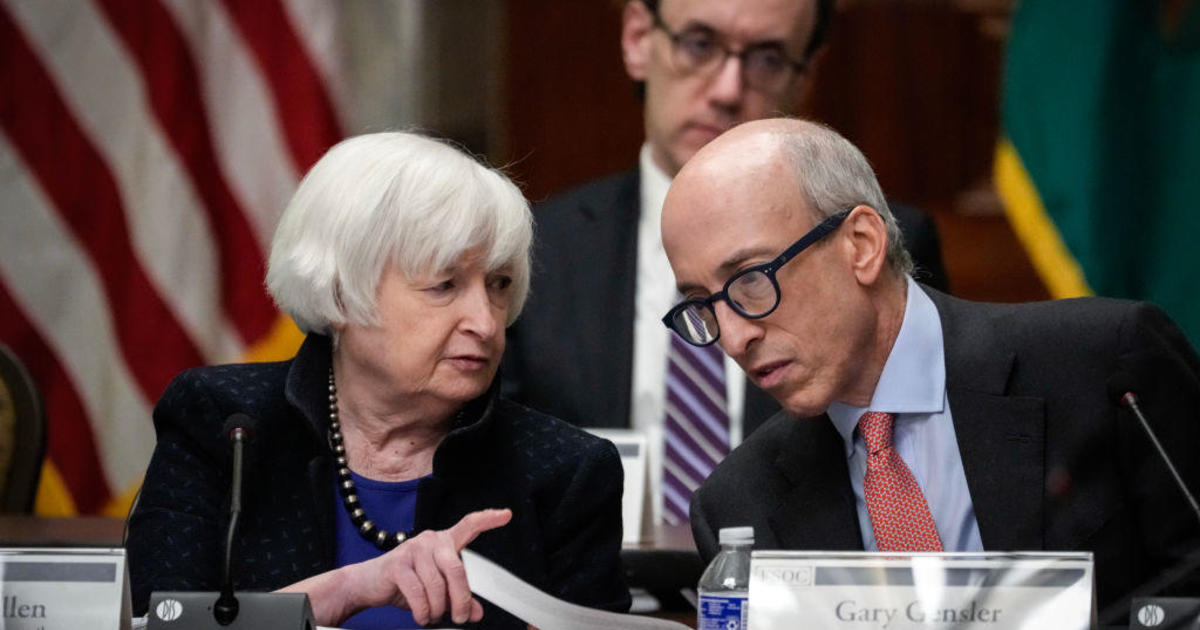A new government report has for the first time identified artificial intelligence as a potential risk to the nation’s financial stability.
The Financial Stability Oversight Council (FSOC) — a group that’s charged with monitoring potential vulnerabilities to the financial sector and counts Treasury Secretary Janet Yellen, Federal Reserve Chair Jerome Powell and Securities and Exchange Commission Chair Gary Gensler as members — acknowledged this risk, along with 13 others, in its annual report, which was released Thursday.
Drew Angerer / Getty Images
“The reliance of AI systems on large datasets and third-party vendors introduces operational risks related to data controls, privacy, and cybersecurity,” the report reads.
In recent years, the rapidly developing technology has been more widely used in the financial sector to help identify patterns. Gensler, however, warned of the inherent risks and said it might heighten financial fragility.
“There are challenges regarding explainability, bias and accuracy,” Genseler said, according to remarks prepared for delivery at the FSOC’s open session meeting Thursday. “AI also can be used by bad actors to deceive people in the markets.”
In May, an AI-generated image purported to show an explosion near the Pentagon. The image, which was determined to be fake, spread across social media, rattling the stock market and causing a brief sell-off.
In her prepared remarks for the meeting, Yellen predicted the adoption of AI will become more widespread and said its usage must be managed carefully.
“Supporting responsible innovation in this area can allow the financial system to reap benefits like increased efficiency, but there are also existing principles and rules for risk management that should be applied,” Yellen said.
Silicon Valley Bank collapse
The report also offered a post mortem on the March collapse of Santa Clara-based Silicon Valley Bank, which ranked as the second largest bank failure in U.S. history and triggered a regional banking crisis.
On March 10, the FDIC seized SVB — as well as New York-based Signature Bank — and guaranteed deposits after a run on the bank saw customers withdraw $42 billion in a single day. Additional measures taken by the Federal Reserve and Treasury Department helped contain the fallout.
The report cited poor risk management and a heavy reliance on uninsured deposits among the reasons for the bank’s failure. Rising interest rates also left the bank in a vulnerable position, leaving it unable to cover its deposit obligations. A separate review in May by the Federal Reserve found that its own regulatory standards were not sufficient.
Going forward, the FSOC “recommends that banking agencies closely monitor uninsured deposit levels and depositor composition and collect additional data as necessary.”
Still, despite the new recommendations and aggressive actions taken in the spring, some risk remains.
“When two regional banking firms and a global financial firm failed last March, FSOC member agencies acted quickly to mitigate the serious risk of contagion and to maintain confidence in the banking system,” Yellen said. “But the failures also underscored that vulnerabilities remain.”
Vulnerabilities in commercial real estate sector
The report identifies another vulnerability for regional and community banks, too — their “significant concentrations” in the commercial real estate sector. It’s estimated that commercial real estate loans total about $6 trillion — and half of those are held by banks.
According to the report, delinquency rates for some commercial real estate loans, especially those backed by office properties, increased in the first half of 2023. Banks expect delinquency rates to continue to rise since demand for office space has continued to slump since the pandemic. Commercial developers are struggling to keep up with their mortgages because office vacancies remain high.
Also, so-called refinancing risk — when borrowers can’t restructure their debt — is elevated “due to the sizeable amount of upcoming maturities in 2024,” the report finds. “These factors can lead to potential financial stability risks if they result in financial distress among financial institutions and investors that spills over into other financial institutions and the broader system.”
Other risks: vulnerabilities in cybersecurity, climate and crypto
Other risks identified in the report include cybersecurity vulnerabilities, climate and cryptocurrencies.
Cyber risk is “pervasive throughout the economy,” the report finds, and the council says enhanced partnership between state and federal agencies and private firms — including information sharing — could be key to mitigating risk.
FSOC is also developing a framework to identify and assess climate risk and recommends “state and federal agencies continue to coordinate to identify, prioritize, and procure data necessary for monitoring climate-related financial risks.”
Digital assets — or cryptocurrencies — pose risks, too, given the volatility of asset prices. The FSOC recommended in its report that Congress pass legislation to regulate stablecoins — which are stable cryptocurrencies pegged to reserve assets like the dollar or gold — and other crypto assets.






